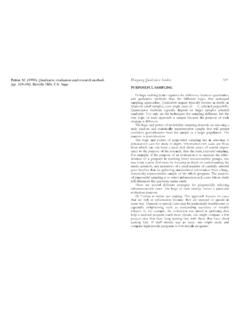Transcription of NICOLE
1 communication on contaminated landNICOLEA Network for Industrially Contaminated Land in EuropeNICOLE is a network for the stimulation, dissemination andexchange of knowledge about all aspects of industrially con-taminated land. Its 125 members of 15 European countriescome from industrial companies and trade organisations(problem holders), service providers/ technology develo-pers, universities and independent research organisations(problem solvers) and governmental organisations (policymakers). The network started in February 1996 as a concer-ted action under the 4th Framework Programme of theEuropean Community.
2 Since February 1999 NICOLE has beenself supporting and is financed by the fees of its members. Further information: NICOLE OMSLAG def 25-10-2004 09:13 Pagina 156 Colofon:Text drs. Schelwald-van der Kley, Schelwald-van der Kley consultancy BV, Philippa Scott, Shell Global SolutionsPictures BP, Dura Vermeer, ENI, Enviars, Environmental Council UK, Fotografia di architettura Federico Brunetti, Gaz de France, GGD Rotterdam, ICI, JM Sweden, NICOLE , Port of Rotterdam, SKB, TNO-MEP, TNO - NITG, Umicore, Visser-WesterweeleLayoutVan Lint Vormgeving, Zierikzee, NLPrintingQuantes, RijswijkNICOLEA Network for Industrially Contaminated Land in EuropeCommunication on contaminated land4428 NICOLE 22-10 25-10-2004 09.
3 09 Pagina 5623"Contaminated land risk assessment and remediation can either bedriven by the need to protect the public and the environment or bybrownfield redevelopment. Whilst brownfield redevelopment bringstangible benefits that can be seen by all, different stakeholdergroups will perceive different ratios of 'costs' (in their broadestsense) to benefits. Where remediation is to protect public healthand the environment, it might be assumed that all stakeholderswould welcome remediation. However, experience has shown thatresponses can range from outright opposition to any action to extreme communication of risks associated with contaminated land tothose who are not directly involved in the project is unique in thesense that soil and groundwater contamination tends to be invisibleand may therefore be perceived as a 'hidden danger' caused by others,with exposure being largely involuntary.
4 It is also often disruptive andwith no perceived direct benefits to many of those is therefore a challenge for companies to communicate contaminatedland issues to their stakeholders and to effectively communicate thepossible options of the necessary actions or measures to be taken. Experience shows that effective communication can lead to a better quality of solution for all parties concerned and to its , the Network for Industrially Contaminated Land in Europe,recognizes the need for practical guidance on risk communication inthe context of sustainable land management.
5 As a follow-up to an ear-lier NICOLE project on risk communication1this NICOLE booklet provi-des further practical guidance and examples. Many industrial and ser-vice providing companies were willing to share their best practicesand communication experiences. Their case studies are described inthis booklet along with the key communication lessons distilled fromthem. I trust that this booklet will be both enjoyable to read and thekey messages valuable when considering the format of your own com-munications with stakeholders on contaminated land issues".Steve WallaceChair of NICOLE & Head of Environment Secondsite PropertyPreface1 NICOLE report: Risk communication on contaminated land, 1999.
6 DOW Benelux NV, ShellInternational Oil Products BV, Solvay , Element Consult, NOK, The Questor Centre, Schelwald-van der Kley BV, TNO-MEP4428 NICOLE 22-10 25-10-2004 09:09 Pagina 25 While enthusiastically collecting all the case material for this bookletand interviewing experienced environmental and communicationmanagers, I tried to distil common, basic principles and find the key(s)to successful communication . The first thing that struck me was thatmost companies were quite willing to share information and werequite open about their communication experiences, either good or open and honest is also one of the key principles for successfulcommunication.
7 I also discovered that most companies put a lot ofeffort in their communication process with stakeholders and are usu-ally well equipped to do so. Of course their reputation may be at stake,but the driving force usually lies deeper. As the case studies camefrom many countries, it became apparent that cultural differencesneed always be taken into account. What works in one place doesn tnecessarily work in another. Involving and working with local people,who are familiar with the local customs, appears to be a wise the end it all seems to come down to a few basic communicationprinciples, such as treating people with respect, listening to their con-cerns, involving them and taking them seriously.
8 Not surprisingly emo-tions come into play, as soil contamination often affects the mainthings people care for, like their personal health, the health of theirloved ones and the value of their property. So addressing technicalissues alone is a strategy that nearly always fails. Another basic prin-ciple is to do what you promised to do and do it on time. Not obeyingthis rule greatly jeopardizes an organisation s trustworthiness. Butperhaps one of the main communication lessons that I noted from thecases is that proactiveness pays off. Proactiveness means not waitingfor problems to surface, having a structured communication system inplace and building up trust before it is needed.
9 Maintaining good rela-tionships is based on mutual respect and regularly communicatingwith stakeholders, such as the local communities. It is the sociallyresponsible thing to do. Like one of the company communicationmanagers I interviewed nicely put it: We owe it to the communitieswhere we operate and we owe it to them that we operate!Of course there is more to communication , than can be described in thisbrief introduction (or even in this booklet). Nevertheless the cases, forwhich I owe my thanks to everyone who contributed, coveran interesting range of issues.
10 In particular, I would like tothank Philippa Scott of Shell Global Solutions for reviewingthe booklet and giving many valuable comments. Enjoy reading the case stories!Lida Schelwald-van der KleyWhat is the key to successful communication ?4 Preface3An introduction by the author5 Proactive approach6 Trust & credibility12 Public & (risk) perception20 Emotions & Control26 Planning & Timing32 Openness & Transparancy40 Clear Language46 Cultural differences50An introduction by the authorContents4428 NICOLE 22-10 25-10-2004 09:09 Pagina 4 Key messagesExampleProactive approachCommunication: a key part of environmental managementWhen a new company acquired a contaminated site, they decided to clean it up using a novel remediationtechnique.








